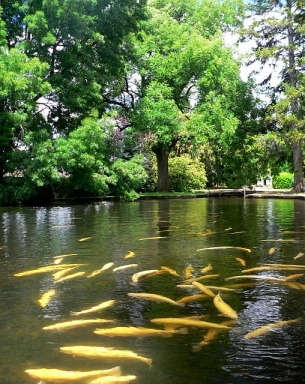The Salmon Forest of Education
The health of a school community is so dependent upon the health of all of its members
Early on in my career in education, I had one of those transformative, paradigm-shifting, change-the-way-I-view the world moments while reading David Suzuki and Holly Dressel’s book From Naked Ape to Superspecies. What really stuck out for me was their explanation of how scientists had discovered that the health of many forests in British Columbia was directly dependent upon the health of salmon populations, and vice versa.

The salmon depend upon the trees to shade the streams and control water temperature, to provide nutrients, and to prevent soil erosion into the spawning beds. At the same time, the nitrogen from salmon remnants scattered across the forest floor by bears, wolves, eagles and ravens is an important source of fertilizer to help the trees’ growth. As trees disappeared, so too did the salmon. And as salmon disappeared, the health of the trees diminished. I was surprised and humbled to realize how interdependent these two seemingly unrelated and very different things, salmon and trees, were upon each other’s well-being.
While the Salmon Forest is a story of major ecological import, I think it is also a story of great social import, and a reminder that the ecological and social can’t be so easily separated. I share this story here in the context of education because it helped me realize that the health of a community is so dependent upon the health of all of its members. Each individual’s well-being is so deeply interwoven with the well-being of the community that it is impossible to create clear divisions.
The importance of biodiversity to the health of an ecosystem is now widely accepted, but I don’t think we’ve quite reached the point where social diversity is considered as essential to the health of communities. We hear much about the importance of “tolerance” or “accommodation” of differences, or about the “problems” posed by increasing diversity, but less about how integral social diversity is to fostering the growth of strong, resilient, supportive communities.
We can’t have healthy, safe communities if students continue to fear bullying and harassment based on parts of their identity, or if they lack access to the same resources that others enjoy. Or if teachers feel unsafe at work or parents and caregivers feel unwelcomed or judged at school.
We know that social, political and economic inequities continue to exist on many levels. We know that racialized groups, especially immigrants and First Nations, Métis and Inuit communities, continue to experience poverty and underemployment at much higher rates than others. We know that students with disabilities, mental health challenges, English as an additional language, or who identify as racialized, a religious minority, or LGBTQ are at greater risk of early school leaving. While males no longer excel at a higher rate than females within the education system, we know that income disparities continue to disadvantage women disproportionately. Knowing this, how do we build communities that are vibrant, strong and poised to succeed in a rapidly changing world?
If the Salmon Forest provides any indication, our success lies in recognizing our interdependency and nurturing the diversity of our communities. While some groups temporarily thrive on inequity at the expense of others, at the end of the day, we all lose, though some certainly experience greater harm than others. We can’t have healthy, safe communities if students continue to fear bullying and harassment based on parts of their identity, or if they lack access to the same resources that others enjoy. Or if teachers feel unsafe at work or parents and caregivers feel unwelcomed or judged at school.
Building vibrant communities requires fostering equity and inclusion, and not just accepting but leveraging the benefits of diverse abilities, ethnicities, cultures, faiths, sizes, genders, sexual orientations, languages and family structures, while working to reduce socioeconomic disparities. It means cultivating in all students and staff a sense of pride in their identity. It means drawing upon the knowledge, skills and resources that all students, parents and community members have to contribute to education. And it means fostering a sense of power to succeed and effect change.
Realizing these goals begins with the self. It begins with examining our own identities and the filters through which we interpret the world. What assumptions might we be making about particular students, staff, or caregivers? How do our own experiences shape our perceptions? How can we challenge ourselves to see things from a different perspective? What other possibilities might exist? Focusing our equity lens enables us to perceive the world in a different way, to notice the ways in which stereotypes and power imbalances might negatively impact some individuals and groups while advantaging others.
A supportive, inclusive and equitable school works together with students, staff, parents/caregivers and community members to create a space in which all participants are provided meaningful opportunities to contribute to and shape the educational experience. It is a place where everyone feels that their identity is not just represented but normalized, where they feel a sense of belonging and are valued as an integral member of the community. A school that fosters the health and well-being of all students anticipates and integrates diversity into the curriculum, instructional and assessment practices, the physical environment, extracurricular activities, outreach to parents and caregivers, resource materials and support services. Healthy schools mean equitable schools, where all students feel set up to succeed to the same extent as their peers.
